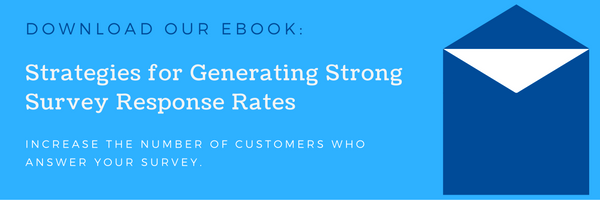One of the greatest determinants of a successful customer satisfaction survey is achieving a strong response rate. While there are varying opinions as to what the minimum ideal survey response rates should be, it’s generally accepted that the higher the percentage of respondents you have, the better. For a more in-depth look at this topic, read our post on survey data.
That sounds simple enough, but take a look at various online forums for discussions about surveys. There, you’ll read countless stories of customers ignoring surveys and survey sponsor pleas for suggestions on how to boost survey response rates. In fact, that’s why we created this EBook:
Today, let’s discuss one way to encourage customers to take surveys: asking front-line employees to prompt customers to respond to your survey, and the advantages and disadvantages of this particular tactic.
Advantages of Employee Involvement
The clear advantage of employee involvement is the existing relationship they have with customers. Think about it. Respondents are getting a nudge from someone they likely have an established relationship with. This makes them more apt to respond, versus the sentiment they might feel after receiving a generic survey reminder generated by survey software. So, your employees can help get in more responses, which equals a higher response rate, which equals a lower margin of error, which equals reliable and representative data.
Front-line personnel can also add a personal touch when conveying the importance of the survey endeavor. The survey communication might be well-written, but when you are speaking with someone you (conceivably) trust, and they tell you that the responses are all reviewed carefully, and the company relies on customer feedback to guide planning / priorities, you are more likely to be receptive to this form of personalization.
Employees can also be more targeted in their outreach. This can be an advantage or disadvantage. If, for example, the company identified that a certain segment of the customer population was under-represented (i.e. high-value customers), the team could conduct targeted outreach toward that segment to ensure there was a valid sample upon closing the survey. The risk here is with gaming since the service team member might only target contacts they feel are more likely to award higher scores. (Keep reading for ways to avoid this.)
Frequency of hearing about your Voice of the Customer program can also positively impact customer response, since discussions can also help keep surveys top of mind. If you decide to empower employees to talk to customers about surveys, the company / front-line team should not just talk about voice of the customer, feedback, surveys, etc. once or twice a year. They should emphasize the importance on an ongoing basis (i.e. during Quarterly Business Reviews, strategic oriented discussions, when the customer offers positive / negative feedback etc.) In other words, the survey mention should be part of an ongoing discussion, so it’s not out of the blue.
Lastly, when employees give customers a heads-up that an invitation is forthcoming, they will be more likely to watch for the survey and respond.
Disadvantages of Employee Involvement
One of the biggest concerns when it comes to asking employees to participate in securing more survey responses is the possibility of introducing bias. This includes “cherry-picking” which contacts you want to respond or begging for high scores.
Most of us can relate to car dealerships or service departments asking us to take a survey. Sometimes its blatantly obvious (“Please rate us a 10, my bonus depends on it!”), but it’s often much subtler. For example, the car salesman may say, “I know this took a bit longer than expected, but hopefully the nice loaner car made it less of a burden for you.”
If employees will be speaking with customers about surveys, you should be coaching them on the type of language they should use to avoid this. For example, they can emphasize the significant role your company places on feedback, and that you carefully review all responses and consider them as you make improvements across the organization. They should not, however, say anything that might be perceived as asking for a high score. (For more ideas, read the next section of the article on preparing employees to promote your survey.)
Another potential disadvantage of employee involvement with surveys is bias that is introduced when someone you may have a relationship with is asking you to complete the survey. In some cases, this may suggest or give the impression that they will be personally reading the response. What if the client has an issue that he or she doesn’t want to discuss with their day-to-day contact? They might be reluctant to comment negatively about that person.
Finally, a common disadvantage is simply time. Depending on the number of accounts each front-line employee manages, contacting all non-responders by email or phone may not be feasible.
Preparing Employees to Promote the Survey
If team members will be used to encourage customer survey participation, we recommend you create a detailed guidebook for employees to follow.
Before employees reach out to customers, be sure they know:
- How many questions are in the survey
- The estimated time it will take to complete it
- How the feedback will be used
Additionally, unprepared employees will only confuse customers (and potentially diminish survey response rates) if they are unable to answer any questions that arise. That’s why we recommend your guidebook include answers to any possible questions customers might ask regarding the survey. These might include:
- Who will be reviewing my responses?
- Will my answers affect my standing with your company?
- May I answer anonymously?
- What’s my incentive for replying?
- Can you give me an example of how a past survey affected changes within your business?
Besides empowering employees to mention a survey based on company-approved messaging when they’re talking with customers, a great way to remind customers about the survey’s existence is to create standardized language that can be added to employee signatures during the survey duration. If a conversation doesn’t yield an immediate survey response, seeing a visual reminder may inspire action.
Identifying Survey Non-Responders
Another important consideration is the type of reporting employees will have access to. We suggest that you provide ongoing reporting during the survey window that shows who responded, who hasn’t, overall response rates, response rates by key verticals, account person, etc.
Without this detail, the outreach process can’t be targeted, and it will come off as less personal. Some survey tools do this well, while others make it difficult to export the unique survey links for each contact invited so they can be emailed directly by front-line personnel.
Make Employee Efforts Worthwhile
As your employees convey the importance of survey participation to customers, make sure to follow through on the commitment your business has given to implement customer feedback by “closing the loop” with respondents. Do this by:
- Sending thank you notes to all survey respondents, while not required, is good practice. For customers who respond after an employee communicates with them, you can have the employee also send a personal note of thanks.
- Follow up with customers after the results have been evaluated to alert them about the general feedback and what steps your business is taking to implement positive change. If specific respondents were responsible for certain changes, you can have the employees who communicated with them send them a personal message about the changes.
- Remind customers that your business is always open to feedback. Besides asking respondents to consider participating in future surveys, offer them a way to directly send feedback as it arises.
If there are still customers who aren’t participating in surveys despite your efforts, it’s time to look for reasons why this might be occurring. A one-question non-responder survey can provide powerful insights, while reaching out to a small random sample of non-responders via a phone call can also clue you in to the silence.


